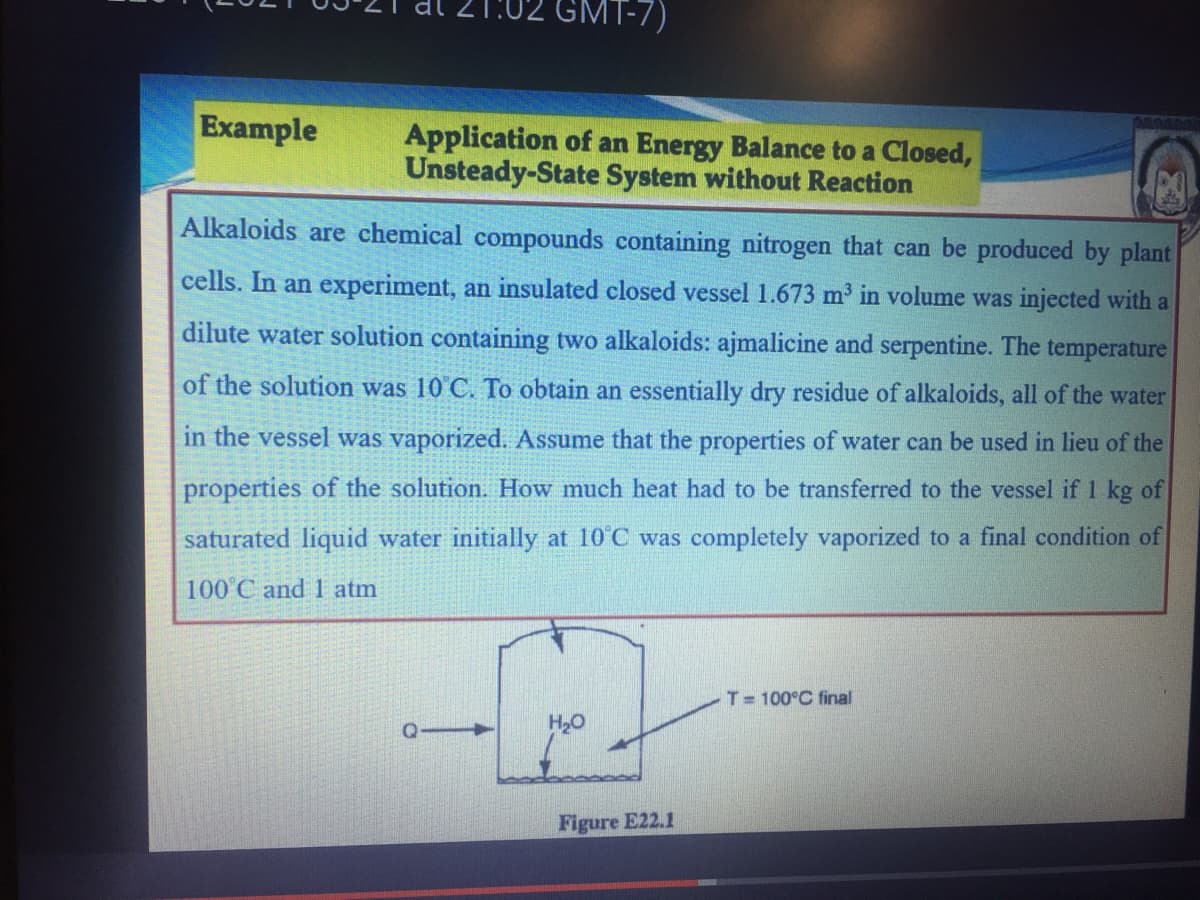Alkaloids are chemical compounds containing nitrogen that can be produced by plant cells. In an experiment, an insulated closed vessel 1.673 m3 in volume was injected with a dilute water solution containing two alkaloids: ajmalicine and serpentine. The temperature of the solution was 10 C. To obtain an essentially dry residue of alkaloids, all of the water in the vessel was vaporized. Assume that the properties of water can be used in lieu of the properties of the solution. How much heat had to be transferred to the vessel if 1 kg of saturated liquid water initially at 10°C was completely vaporized to a final condition of 100°C and 1 atm T 100°C final H20
Alkaloids are chemical compounds containing nitrogen that can be produced by plant cells. In an experiment, an insulated closed vessel 1.673 m3 in volume was injected with a dilute water solution containing two alkaloids: ajmalicine and serpentine. The temperature of the solution was 10 C. To obtain an essentially dry residue of alkaloids, all of the water in the vessel was vaporized. Assume that the properties of water can be used in lieu of the properties of the solution. How much heat had to be transferred to the vessel if 1 kg of saturated liquid water initially at 10°C was completely vaporized to a final condition of 100°C and 1 atm T 100°C final H20
Chemistry
10th Edition
ISBN:9781305957404
Author:Steven S. Zumdahl, Susan A. Zumdahl, Donald J. DeCoste
Publisher:Steven S. Zumdahl, Susan A. Zumdahl, Donald J. DeCoste
Chapter1: Chemical Foundations
Section: Chapter Questions
Problem 1RQ: Define and explain the differences between the following terms. a. law and theory b. theory and...
Related questions
Question

Transcribed Image Text:GMT-7)
Example
Application of an Energy Balance to a Closed,
Unsteady-State System without Reaction
Alkaloids are chemical compounds containing nitrogen that can be produced by plant
cells. In an experiment, an insulated closed vessel 1.673 m in volume was injected with a
dilute water solution containing two alkaloids: ajmalicine and serpentine. The temperature
of the solution was 10 C. To obtain an essentially dry residue of alkaloids, all of the water
in the vessel was vaporized. Assume that the properties of water can be used in lieu of the
properties of the solution. How much heat had to be transferred to the vessel if 1 kg of
saturated liquid water initially at 10 C was completely vaporized to a final condition of
100°C and 1 atm
T 100°C final
H20
Figure E22.1
Expert Solution
This question has been solved!
Explore an expertly crafted, step-by-step solution for a thorough understanding of key concepts.
Step by step
Solved in 3 steps with 2 images

Knowledge Booster
Learn more about
Need a deep-dive on the concept behind this application? Look no further. Learn more about this topic, chemistry and related others by exploring similar questions and additional content below.Recommended textbooks for you

Chemistry
Chemistry
ISBN:
9781305957404
Author:
Steven S. Zumdahl, Susan A. Zumdahl, Donald J. DeCoste
Publisher:
Cengage Learning

Chemistry
Chemistry
ISBN:
9781259911156
Author:
Raymond Chang Dr., Jason Overby Professor
Publisher:
McGraw-Hill Education

Principles of Instrumental Analysis
Chemistry
ISBN:
9781305577213
Author:
Douglas A. Skoog, F. James Holler, Stanley R. Crouch
Publisher:
Cengage Learning

Chemistry
Chemistry
ISBN:
9781305957404
Author:
Steven S. Zumdahl, Susan A. Zumdahl, Donald J. DeCoste
Publisher:
Cengage Learning

Chemistry
Chemistry
ISBN:
9781259911156
Author:
Raymond Chang Dr., Jason Overby Professor
Publisher:
McGraw-Hill Education

Principles of Instrumental Analysis
Chemistry
ISBN:
9781305577213
Author:
Douglas A. Skoog, F. James Holler, Stanley R. Crouch
Publisher:
Cengage Learning

Organic Chemistry
Chemistry
ISBN:
9780078021558
Author:
Janice Gorzynski Smith Dr.
Publisher:
McGraw-Hill Education

Chemistry: Principles and Reactions
Chemistry
ISBN:
9781305079373
Author:
William L. Masterton, Cecile N. Hurley
Publisher:
Cengage Learning

Elementary Principles of Chemical Processes, Bind…
Chemistry
ISBN:
9781118431221
Author:
Richard M. Felder, Ronald W. Rousseau, Lisa G. Bullard
Publisher:
WILEY